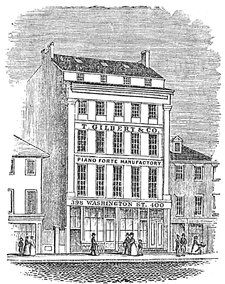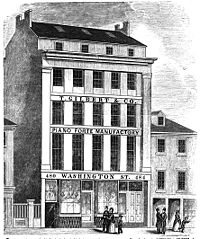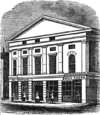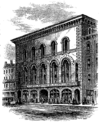
Timothy Gilbert
Encyclopedia

Piano
The piano is a musical instrument played by means of a keyboard. It is one of the most popular instruments in the world. Widely used in classical and jazz music for solo performances, ensemble use, chamber music and accompaniment, the piano is also very popular as an aid to composing and rehearsal...
manufacturer, abolitionist and religious organizer in Boston, Massachusetts. His brother Lemuel Gilbert (February 10, 1804–February 27, 1864) was also a piano manufacturer.
Gilbert was born in Enfield, Massachusetts
Enfield, Massachusetts
Enfield was formerly a town in Hampshire County, Massachusetts, incorporated in 1816 from portions of Greenwich and Belchertown. It was named in honor of one of its early settlers, Robert Field...
, the second child of Timothy Gilbert and Fear Shaw and worked on his father's farm until the age of 21. He arrived in Boston December 1818, where he apprenticed with cabinet maker Levi Ruggles, and later worked for piano maker John Osborn before becoming a piano maker in his own right. He was an active member of the Baptist Church, to which he converted in 1817, and was an outspoken abolitionist. He maintained his home as a station of the Underground Railroad
Underground Railroad
The Underground Railroad was an informal network of secret routes and safe houses used by 19th-century black slaves in the United States to escape to free states and Canada with the aid of abolitionists and allies who were sympathetic to their cause. The term is also applied to the abolitionists,...
, and on the passage of the Fugitive slave laws
Fugitive slave laws
The fugitive slave laws were laws passed by the United States Congress in 1793 and 1850 to provide for the return of slaves who escaped from one state into another state or territory.-Pre-colonial and Colonial eras:...
Gilbert announced in the papers that his door would remain open to runaway slaves. He was also member and director in secular charitable organizations and served as president of the Boylston Bank from 1855 to 1860.
Gilbert married Mary Wetherbee in 1823 (Ashburnham, Mass.
Ashburnham, Massachusetts
As of the census of 2000, there were 5,546 people, 1,929 households, and 1,541 families residing in the town. The population density was 143.4 people per square mile . There were 2,204 housing units at an average density of 57.0 per square mile...
, July 7, 1796–December 1843), and their only child, Mary Eunice, was born June 8, 1827. Following Mary's death, Gilbert married Alice Davis November 28, 1844, and in 1846 they adopted Alice (b.April 23, 1846). Their second daughter, Martha Fear Gilbert, was born April 27, 1847.
Gilbert died July 19, 1865 at his home in Boston. His funeral was held at the Tremont Temple
Tremont Temple
The Tremont Temple on 88 Tremont Street is a Baptist church in Boston, affiliated with the American Baptist Churches, USA. The existing structure opened in May 1896 and was designed by architect Clarence Blackall.-History:...
at the expense of the Evangelical Baptist Benevolent and Missionary Society, both of which he had been instrumental in forming. He is buried at Mount Auburn cemetery.
Currier & Gilbert
Gilbert entered a partnership with piano maker Ebenezer Currier (1801–1835) by 1826, and they were listed at 393 Washington street by 1829, but dissolved that spring. Currier, with new partner Philip Brown, opened a showroom on the first floor, where they offered "all kinds of Upright & Horizontal Piano Fortes...embracing the latest improvements," and in 1831 he patented a square piano with hammers above the strings.402 and 406 Washington street; 393 and 400 Washington street
Gilbert established his own factory in Osborn's former workshops at 402 Washington street, near Beach street. By 1834 the firm reorganized as T. Gilbert & Company, with Gilbert's brother Lemuel Gilbert and brother in law Henry Safford (1802-c.1872) as partners. In 1835 their address was listed as 400 Washington street, and this year only included 393 Washington—the entry for Currier was his last and did not give a business address—and in 1836 brother in law Increase Gilbert was admitted as partner. In 1837 T. Gilbert & Co. were awarded a silver medal for one of the pianos they showed at the Exhibition of the Massachusetts Charitable Mechanic AssociationMassachusetts Charitable Mechanic Association
The Massachusetts Charitable Mechanic Association of Boston, Massachusetts, was "formed for the sole purposes of promoting the mechanic arts and extending the practice of benevolence." Founding members included Paul Revere, Benjamin Russell, and others...
, placed after fellow Boston manufacturers Chickering & Co., Wilkins & Newhall, and Hallet & Allen for the tone and slightly heavy touch of their piano, but the company was removed from competition at the following exhibition for advertising "the fact, that they have not, to their knowledge, a personal friend among the selected judges." They received a silver medal for a horizontal piano at the 1839 Franklin Institute exhibition in Philadelphia, and a diploma for the third best square piano at the 1841 exhibition in Boston.
In 1841 Gilbert patented improvements in uprights in which he claimed a spring attached to the hammer butt for the combined purposes of returning the hammer to its resting position, reseating the damper against the strings, and keeping the hammer in communication with the key, and he also included a screw adjustment for jack position and damper timing, and a secondary notch on the hammer butt to facilitate shakes and trills. Piano historian Daniel Spillane described that this patent was for "a number of ideas and inventions relating to uprights and squares… and a number of lesser improvements which came to nothing", but considered the upright action significant because it "outlined many ideas afterward claimed by Wornum
Robert Wornum
Robert Wornum was a piano maker working in London during the first half of the 19th century. He is best known for introducing small cottage and oblique uprights and an action considered to be the predecessor of the modern upright action which was used in Europe through the early 20th century...
… in England", referring to an 1842 patent by this manufacturer that Edgar Brinsmead dubbed the "tape-check action" in the 1879 edition of his History of the Pianoforte, in which the last claim was for methods coupling the damper and hammer.
The same year Gilbert was assigned tuner Edwin Fobes' patent for manufacturing hammers with a layer of soft leather covering a block of cork glued to the top portion of the hammer molding. Gilbert also licensed the Aeolian attachment patented by independent mechanic Obed. Coleman in 1844, which fitted a simple reed organ
Reed organ
A reed organ, also called a parlor organ, pump organ, cabinet organ, cottage organ, is an organ that generates its sounds using free metal reeds...
onto the bottom plank of an ordinary square piano, arranged to be played by the ordinary piano keys. Spillane described that Gilbert & Co. licensed the invention in 1846 "for a small figure"—an article about the inventor from January 1845 reported that the firm paid $25,000 for the exclusive rights to manufacture and sell pianos with it in Massachusetts, while New York manufacturers Nunns & Clark paid $25,000 in cash and offered $50,000 royalties for its use in the rest of the country. Spillane wrote that although the Aeolian attachment received some notice as a novelty in the Boston and New York papers, "little came of this…it having been proved that the piano section, at least, required to be tuned every month to keep it in tolerably good condition" a charge the firm reported had been raised by "many of the piano forte makers and others in their interest" and which they attempted to meet when they advertised in 1850 they would thereafter install the attachment only in pianos built expressly for it.
William H. Jameson joined the company as a partner about 1843. Jameson married Gilbert's daughter Mary Eunice.
Patent Aeolian Pianoforte Manufactory

Boylston Market
Boylston Market , designed by architect Charles Bulfinch, was located in Boston, Massachusetts, on the corner of Boylston and Washington Streets. Boylston Hall occupied the third floor of the building, and functioned as a performance and meeting space.-History:The Boylston Market Association...
. According to their entry in the The Stranger's Guide in the City of Boston published in 1848 the new facilities cost about $20,000 and together with two buildings in the rear occupied over 8000 square feet (743.2 m²), the whole being powered and heated by steam, and in a brief and not entirely reliable retrospective of the Boston piano industry published by the Boston Globe in 1915, Arthur Brayley described that the warerooms were connected by bridges with the factory across the yard, and an underground passage connected the machine shop with the boiler room, "which was said to be a refuge for runaway slaves". The sketch of the firm for Edwin Freedley's Leading Pursuits and Leading Men of 1856 described that they manufactured every part of their pianos except the cases on their own premises, and although their operations were conducted in from twenty-five to thirty rooms they went on "with the most perfect order and system." The 1848 article also stated the firm employed about sixty workers, and had manufactured between 3,000 and 4,000 pianos, upwards 500 of them with the Aeolian attachment.
In 1847 Gilbert patented a cast iron frame for grand pianos with the ordinary resisting bars combined with bars perpendicular to the strings—one of which was to be connected with the front edge of the sounding board—in order to prevent the case sides from twisting, as well as a double action for horizontal pianos with springs meant to support the weight of the hammers and dampers in order to lighten the touch of the keys.
In 1850 Gilbert listed $80,000 capital, with eighty workers and sales worth $112,500, making him the second largest piano manufacturer in Boston after Jonas Chickering
Jonas Chickering
Jonas Chickering was a piano manufacturer in Boston, Massachusetts.Jonas Chickering was born in Mason Village, and raised in nearby New Ipswich, New Hampshire where his father Abner Chickering kept a farm and worked as a blacksmith...
. The Rich Men of Massachusetts, published in 1851, stated Gilbert had made more than 4,400 pianos to date, upwards 1,100 with the Aeolian attachment, and estimated his fortune as $100,000. T. Gilbert & Co. were awarded a diploma for a piano with the aeolian attachment exhibited by piano dealers Waters & Berry at the 1850 American Institute fair, placed third after D. Benson & Co., of Buffalo, and J. H. Grovesteen of New York.
In 1851 Gilbert patented actions for horizontal and vertical pianos where escapement was operated by a lower extension of the hammer butt instead of by a fixed button in order to reduce the number of parts to allow a lighter touch, and with an additional projection to limit the motion of the jack to improve repetition. They granted their New York and general agencies to Horace Waters the same year, and Waters advertised their iron frame squares with the circular scale as well as upright grands and boudoir pianos. Gilbert & Co. received honorable mention for a square piano with the Aeolian attachment at the 1851 London Exhibition, a silver medal for the second best piano at the 1851 American Institute fair, a diploma for an aelioan attachment at the 1852 American Institute fair and a bronze medal for the third best square at the 1853 Exhibition of the Massachusetts Charitable Mechanic Association.
484 Washington street

In 1856 they advertised they had made upwards of 6,000 pianos, as many as 2,300 with the Aeolian attachment. They were awarded a bronze medal for the third best grand action piano at the American Institute Fair, after Chickering & Sons and Steinway & Sons, and a silver medal for a grand piano and a bronze medal for a square at the Exhibition of the Massachusetts Charitable Mechanic Association. In 1857 they advertised they had adopted all new scales, as well as a "new improved action", and by 1859 advertised having made nearly 8,000 pianos, including squares, full grand and orpheons, directing attention to their obliquely strung parlor grands "as superior to all others now manufactured". They were awarded a silver medal for grands and parlor grands, after Chickering & Sons, and a bronze medal for a piano with an aeolian attachment at the 1860 Exhibition of Massachusetts Charitable Mechanic Association, where their grand piano was judged to be "an instrument of great excellence, and equalled by few."
By 1864 they were listed at 20 Beach street only.
The Free Baptist Church
Gilbert was originally a member of the Charles Street Baptist church, but left it for the Federal Street church which was more aligned with his views on slavery—Fulton wrote it had been said Gilbert first tested his new congregation by "fill[ing] his pew with colored people [and that] no one objected", but more recent accounts state he was expelled from the Charles street church for this reason—and left the Federal Street church April 1839 to join the Free Baptist church whose first services were held April 21, 1839 at Baldwin Place, with 82 attending. A sermon was given by the congregation's future first pastor Nathaniel Colver, with whom Gilbert had corresponded since Colver's lecturing tour the previous year year.The non-segregated
Racial segregation
Racial segregation is the separation of humans into racial groups in daily life. It may apply to activities such as eating in a restaurant, drinking from a water fountain, using a public toilet, attending school, going to the movies, or in the rental or purchase of a home...
, anti-slavery, temperance
Temperance movement
A temperance movement is a social movement urging reduced use of alcoholic beverages. Temperance movements may criticize excessive alcohol use, promote complete abstinence , or pressure the government to enact anti-alcohol legislation or complete prohibition of alcohol.-Temperance movement by...
, and anti-secret society
Secret society
A secret society is a club or organization whose activities and inner functioning are concealed from non-members. The society may or may not attempt to conceal its existence. The term usually excludes covert groups, such as intelligence agencies or guerrilla insurgencies, which hide their...
Free Church first met in a room on Tremont Row
Tremont Row
Tremont Row in Boston, Massachusetts, was a short street that flourished in the 19th and early-20th centuries. It was located near the intersection of Court, Tremont, and Cambridge streets, in today's Government Center area. It existed until the 1920s, when it became known as Scollay Square...
, then at Congress Hall, and at the Museum Building at the corner of Bromfield and Tremont Streets, and by 1841 had 325 members
The Tremont Temple

William S. Damrell
William Shapleigh Damrell was a member of the United States House of Representatives from Massachusetts. He was born in Portsmouth, New Hampshire on November 29, 1809. He attended public schools, learned the art of printing and became the proprietor of a large printing establishment in Boston...
raised $55,000 to purchase the failed Tremont Theater
Tremont Theatre, Boston
The Tremont Theatre on 88 Tremont Street was a playhouse in Boston. A group of wealthy Boston residents financed the building's construction. Architect Isaiah Rogers designed the original Theatre structure in 1827 in the Greek Revival style...
on School Street in order to establish a permanent and self-supporting home for the church. The building was remodelled at the additional cost of more than $24,000, during which time Gilbert left the management of his business with his partner Jameson. The Tremont Temple was dedicated December 1843, and the free-seat church was supported by renting out its storefronts and offices, as well as the 88 feet (26.8 m) by 90 feet (27.4 m), 2,000 seat hall. The deed for the building and land was transferred by the four owners to a trust in 1844.
The Tremont Temple burned on March 31, 1852, destroying it and a neighboring building. Early estimates put losses at about $200,000, including the building, which was insured for $42,000, A. J. Shepard's piano and music store valued at $8,000, and Thomas Thompson's collection of paintings valued $45,000.

By 1855 the four trustees found it impossible to continue holding the property, and at a meeting of prominent local Baptists that March it was determined that the property be secured to the denomination. It was arranged to transfer it temporarily to a group of thirty-seven until the necessary subscriptions for a new society for the purpose were raised, and in June the deed was conveyed to trustees Thomas Richardson, Frederick Gould, J. W. Converse, G. W. Chipman and J. W. Merrill for $37,000 more than the outstanding liabilities. An act of incorporation was secured for the Evangelical Baptist Benevolent and Missionary Society in 1857; it was organized the following May, the deed transferred to it in November, and in June, 1859 the society executed a lease granting the use of the great hall, organ and furniture to the Tremont Street Baptist Church and Society for a free seet church on Sundays.
The second Tremont Temple burned August 14, 1879, with an estimated loss of $200,000. It was insured for $100,000. It was rebuilt the following year for about $180,000 and was destroyed in a fire March 19, 1893.
American Baptist Anti-Slavery Convention
Gilbert joined the American Baptist Anti-Slavery Convention, formed at the Tremont Chapel in 1840, which published a series of inflammatory letters denouncing slave-holding as an ungraduated sin which precipitated a rift in the theoretically neutral Triennial Convention. The abolitionists were excluded from the ballots at the 1841 convention, and lost an influential position on the Board of Foreign Missions, and in response the Anti-Slavery Convention formed their own provisional foreign committee in 1842. Gilbert was elected treasurer and was charged with collecting funds that otherwise would be donated to the American Board of Foreign MissionsAmerican Board of Commissioners for Foreign Missions
The American Board of Commissioners for Foreign Missions was the first American Christian foreign mission agency. It was proposed in 1810 by recent graduates of Williams College and officially chartered in 1812. In 1961 it merged with other societies to form the United Church Board for World...
—he explained later "the majority of the abolitionists have not so much objection to receive the money of slaveholders, as to be associated with them in evangelizing the world, and thus, by the copartnership, acknowledge them to be Christians in good standing in the Baptist church."
Gilbert sent funds to missionaries, including Adoniram Judson
Adoniram Judson
Adoniram Judson, Jr. was an American Baptist missionary, who served in Burma for almost forty years. At the age of 25, Adoniram Judson became the first Protestant missionary sent from North America to preach in Burma...
and Jonathan Wade, providing they affirmed they were abolitionists, and even proposed establishing missions entirely independent of the Board of Foreign Missions, but refrained from joining the American and Foreign Missionary Society (later called the American Baptist Free Mission Society) which attracted many of his colleagues, stating "When I shall become convinced, that there is no good reason to hope that the old missionary organization will purge itself from the charge of receiving money in such a way as to enter into a copartnership with slaveholders, and giving its sanction to that wicked institution, then I shall be prepared to abandon them, not provisionally, but forever." In 1845 the Anti-Slavery Convention as well as the provisional committee were dissolved, after the formation of the Southern Baptist Convention
Southern Baptist Convention
The Southern Baptist Convention is a United States-based Christian denomination. It is the world's largest Baptist denomination and the largest Protestant body in the United States, with over 16 million members...
and dissolution of the Triennial Convention, and Gilbert joined the mainstream Missionary Union.

